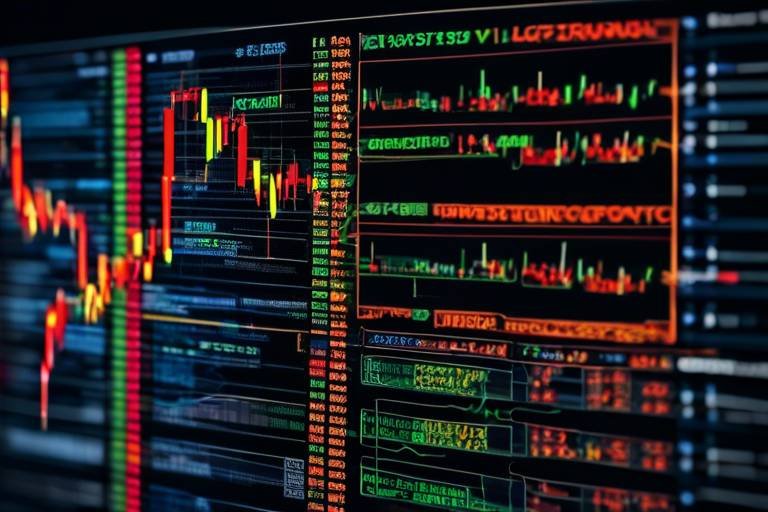How to Develop a Trading Routine
Developing a trading routine is not just about following a set of rules; it's about creating a lifestyle that supports your trading ambitions. Think of it as building a sturdy bridge that connects your aspirations with reality. A well-structured routine can help you navigate the turbulent waters of the financial markets, providing you with the discipline and focus needed to succeed. So, why is it so important to have a trading routine? Well, without one, traders often find themselves adrift, making impulsive decisions based on emotions rather than logic. This article will walk you through the essential components of crafting an effective trading routine that can enhance your performance and consistency.
When it comes to trading, having a well-defined routine is crucial for success. It’s like having a compass that guides you through the fog of uncertainty. A solid routine helps traders maintain discipline, manage their emotions, and make informed decisions. This leads to better trading outcomes, allowing you to capitalize on opportunities without getting swept away by fear or greed. Imagine trying to navigate a ship without a map; it’s chaotic and unpredictable. That's what trading without a routine feels like. By establishing a clear routine, you can create a sense of stability in an otherwise volatile environment.
Establishing clear, achievable trading goals is the foundation of a successful routine. Goals give you a target to aim for and a way to measure your progress. When you set goals, you are essentially creating a roadmap that guides your trading journey. But how do you define these goals? It's essential to differentiate between short-term and long-term objectives, as each serves a unique purpose in your overall trading strategy. Short-term goals might focus on daily or weekly performance, while long-term goals could be about building wealth over several years. By understanding the distinction, you can tailor your approach to meet your specific needs.
Short-term goals are like stepping stones that help you build momentum in your trading. They can be as simple as aiming for a specific percentage gain over a week or successfully executing a set number of trades. On the other hand, long-term goals are akin to the horizon; they provide a vision of where you want to be in the future. For instance, a long-term goal could be to achieve financial independence through trading within the next five years. Both types of goals are essential, as they work in tandem to enhance your trading performance.
Utilizing the SMART criteria can significantly enhance your goal-setting process. SMART stands for Specific, Measurable, Achievable, Relevant, and Time-bound. By applying this framework, you can create goals that are clear and actionable. For example, instead of saying, "I want to be a better trader," you could set a SMART goal like, "I want to increase my trading account by 15% over the next three months by trading only in my area of expertise." This specificity not only makes your goals more tangible but also allows you to track your progress effectively.
Flexibility in your trading goals is essential. The financial markets are dynamic, and what works today might not work tomorrow. Periodically reviewing and adjusting your goals based on market conditions and personal performance is crucial. For instance, if you find that your initial goal was too ambitious due to unforeseen market volatility, it’s okay to recalibrate. This adaptability will keep you grounded and focused, allowing you to navigate changes without losing sight of your overall objectives.
Creating a structured daily trading schedule can greatly improve your focus and consistency. A well-planned day includes preparation, execution, and review phases. Start by dedicating time each morning to analyze market conditions and refine your trading strategies. During trading hours, stick to your plan and avoid distractions. After the market closes, take time to review your trades, assess what worked and what didn’t, and adjust your strategies accordingly. This routine not only keeps you organized but also reinforces discipline in your trading practice.
Risk management is a critical component of any trading routine. It’s like wearing a seatbelt in a car; it won’t prevent accidents, but it will protect you when they occur. Various strategies can help protect your capital and minimize losses while trading. Understanding these strategies is fundamental to maintaining a sustainable trading routine.
Knowing how to calculate and apply risk-reward ratios is essential for successful trading. This ratio helps you assess potential risks against expected rewards for informed decision-making. For instance, if you risk $100 to potentially gain $300, your risk-reward ratio is 1:3. This means that for every dollar you risk, you stand to gain three. Understanding this concept allows you to make better-informed decisions, ensuring that the potential rewards outweigh the risks.
Stop-loss orders are a vital tool for managing risk. They act as a safety net, automatically closing a trade when it reaches a certain loss level. By effectively using stop-loss orders, you can protect your investments and maintain discipline in your trading routine. Imagine you’re on a roller coaster; a stop-loss is like the safety harness that keeps you secure during the wild ride. It allows you to participate in the thrill of trading while minimizing the potential for devastating losses.
- What is a trading routine? A trading routine is a structured plan that outlines your trading activities, including preparation, execution, and review.
- Why is risk management important? Risk management helps protect your capital and minimizes potential losses, ensuring long-term sustainability in trading.
- How often should I review my trading goals? It's advisable to review your trading goals periodically, especially after significant market changes or personal performance shifts.

Understanding the Importance of a Trading Routine
A well-defined trading routine is crucial for success in the financial markets. Imagine trying to navigate a ship without a compass; it’s chaotic and often leads to disastrous results. Similarly, without a structured routine, traders can easily lose their way, falling prey to emotional decision-making and impulsive trades. A solid trading routine helps in maintaining discipline, managing emotions, and making informed decisions, ultimately leading to better trading outcomes.
One of the most significant benefits of having a trading routine is the ability to establish consistency. Just like a musician practices daily to master their craft, a trader must engage in regular habits that foster skill development and market understanding. Consistency in trading not only enhances performance but also builds confidence over time. When you follow a routine, you’re less likely to be swayed by market noise or emotional highs and lows, allowing you to execute trades based on logic rather than impulse.
Moreover, a trading routine serves as a safety net during turbulent market conditions. When the markets are volatile, emotions can run high, leading to rash decisions that can jeopardize your capital. A structured routine acts as a guide, reminding you to stick to your plan and adhere to your risk management strategies. This is especially important because, in trading, the psychological aspect often outweighs technical skills. A disciplined approach can help mitigate the fear and greed that often cloud judgment.
Additionally, a trading routine can significantly improve your analytical skills. By dedicating specific times for analysis, you can develop a deeper understanding of market trends, price actions, and trading signals. This analytical phase is vital as it allows you to backtest strategies, review past trades, and learn from mistakes. Over time, this practice not only sharpens your trading abilities but also enhances your overall market acumen.
In summary, the importance of a trading routine cannot be overstated. It’s your roadmap in the often unpredictable world of trading. Here are a few key points to consider:
- Discipline: Helps maintain focus and reduces emotional trading.
- Consistency: Establishes a reliable approach that can lead to improved results.
- Risk Management: Provides a framework for protecting your capital.
- Analytical Skills: Enhances your ability to understand and react to market movements.
Ultimately, a trading routine is not just a set of rules; it’s a lifestyle choice that can profoundly impact your trading success. By committing to a routine, you’re investing in your future as a trader, equipping yourself with the tools needed to navigate the complexities of the market with confidence and clarity.

Setting Clear Trading Goals
Establishing clear, achievable trading goals is the foundation of a successful routine. Just like a ship needs a destination to sail towards, traders require specific objectives to navigate the often-turbulent waters of the financial markets. Without these goals, you might find yourself drifting aimlessly, reacting to market movements rather than proactively shaping your trading journey. So, how do you define these goals? It’s essential to start by understanding your personal trading style and risk tolerance. Are you a conservative trader looking for steady growth, or a more aggressive one aiming for higher returns? Knowing this will guide you in setting meaningful targets.
When it comes to trading goals, it's crucial to differentiate between short-term and long-term objectives. Short-term goals might include daily profit targets or specific trade setups you want to master over the next few weeks. On the other hand, long-term goals could involve achieving a certain percentage return on your investment over the course of a year or developing a robust trading strategy that you can rely on. Understanding the purpose of each type of goal allows you to create a balanced approach that can adapt to the ever-changing market conditions.
Short-term goals are like the stepping stones on your trading path. They provide immediate focus and motivation, helping you to stay engaged and refine your skills. In contrast, long-term goals serve as the overarching vision that keeps you grounded during the inevitable ups and downs of trading. For example, a trader might set a short-term goal of executing five successful trades this week while aiming for a long-term goal of increasing their trading account by 20% over the next year. Both types of goals are essential; they complement each other and help you maintain a steady trajectory towards success.
One effective way to enhance your goal-setting process is by utilizing the SMART criteria. SMART stands for Specific, Measurable, Achievable, Relevant, and Time-bound. Applying this framework to your trading objectives can significantly increase your chances of success. For instance, instead of saying, "I want to make money trading," a SMART goal would be, "I aim to achieve a 5% return on my trading account within the next month by focusing on three specific trading strategies." This level of clarity not only makes your goal more attainable but also provides a clear roadmap to follow.
Flexibility in your trading goals is essential. The markets are dynamic, and what works today might not work tomorrow. Therefore, it’s important to periodically review and adjust your goals based on current market conditions and your personal performance. For example, if you find that your initial goal of achieving a 10% return in a volatile market is unrealistic, it’s okay to recalibrate your expectations. Remember, trading is not just about sticking to your original plan; it’s about adapting to the environment while keeping your ultimate objectives in sight. This adaptability can be the difference between a successful trader and one who struggles to keep afloat.
In conclusion, setting clear trading goals is not just a task; it's an art that requires introspection, planning, and flexibility. By understanding the importance of both short-term and long-term objectives, utilizing the SMART framework, and being willing to adjust your goals as needed, you can create a robust foundation for your trading routine. This approach will not only enhance your trading performance but also help you maintain the discipline necessary to navigate the unpredictable world of trading.
- What are the benefits of setting trading goals? Setting trading goals helps maintain focus, manage emotions, and provides a clear roadmap for success.
- How often should I review my trading goals? It's advisable to review your goals regularly, at least monthly, to ensure they remain relevant and achievable.
- Can I change my trading goals? Absolutely! Flexibility is key in trading; adjust your goals based on market conditions and personal performance.
- What is the SMART criteria? SMART stands for Specific, Measurable, Achievable, Relevant, and Time-bound, and it's a framework for setting effective goals.

Short-Term vs. Long-Term Goals
When it comes to trading, understanding the difference between short-term and long-term goals is vital for your success. Think of short-term goals as the sprint in a marathon; they help you gain quick wins and build momentum. On the other hand, long-term goals are like the marathon itself, requiring endurance, patience, and a strategic approach. Both types of goals serve unique purposes in your trading journey, and recognizing how they complement each other can significantly enhance your performance.
Short-term goals typically focus on quick gains and immediate results. For instance, you might aim to achieve a specific percentage return within a week or set a target for the number of successful trades you want to execute in a month. These goals can keep you motivated and provide a sense of accomplishment, but they can also lead to impulsive decisions if you’re not careful. It’s essential to remain disciplined and not let the thrill of quick profits cloud your judgment.
In contrast, long-term goals are all about sustainability and growth. They might include aspirations like building a robust trading portfolio over the next five years or developing a consistent monthly income from trading. Long-term goals require a more measured approach, where you evaluate your strategies and adapt to market changes over time. They often involve a deeper analysis of your trading style, risk tolerance, and overall market trends.
To illustrate the differences between short-term and long-term goals, consider the following table:
| Aspect | Short-Term Goals | Long-Term Goals |
|---|---|---|
| Time Frame | Days to Weeks | Months to Years |
| Focus | Quick Wins | Sustainable Growth |
| Risk Level | Higher | Lower |
| Decision Making | Impulsive | Strategic |
By setting both short-term and long-term goals, you create a balanced approach to trading. Short-term goals can provide the thrill and motivation needed to keep you engaged, while long-term goals ensure that you remain focused on your ultimate objectives. However, it’s crucial to remember that flexibility is key. Markets are dynamic, and your goals should evolve with them. Regularly reviewing and adjusting your goals can help you stay aligned with both your personal growth and the ever-changing trading landscape.
- Why are short-term goals important in trading? Short-term goals help maintain motivation and provide quick feedback on your trading strategies.
- How often should I review my trading goals? It's advisable to review your goals at least quarterly, or more frequently if market conditions change significantly.
- Can I have too many short-term goals? Yes, having too many can lead to overwhelm and distraction. It's best to focus on a few key objectives.

SMART Goals Framework
This article explores the essential components of creating an effective trading routine, including strategies, discipline, and psychological preparation to enhance trading performance and consistency.
A well-defined trading routine is crucial for success. It helps traders maintain discipline, manage emotions, and make informed decisions, ultimately leading to better trading outcomes.
Establishing clear, achievable trading goals is the foundation of a successful routine. This section discusses how to define short-term and long-term objectives that align with your trading style.
Differentiating between short-term and long-term goals is vital. This part explains how each type of goal serves a unique purpose in your overall trading strategy and performance.
Utilizing the SMART criteria is an effective way to enhance your goal-setting process. The acronym stands for Specific, Measurable, Achievable, Relevant, and Time-bound. Each element plays a crucial role in ensuring that your goals are not just vague aspirations but concrete targets that can guide your trading activities.
To break it down:
- Specific: Your goals should be clear and specific. Instead of saying, “I want to make money,” specify how much you want to earn and in what timeframe.
- Measurable: Incorporate metrics to track your progress. This could be in terms of percentage gains or the number of successful trades.
- Achievable: Set realistic goals that challenge you but are still attainable. Aiming to double your investment in a week might not be feasible.
- Relevant: Ensure your goals align with your overall trading strategy and personal circumstances. For instance, if you’re a part-time trader, your goals should reflect the time you can realistically dedicate.
- Time-bound: Assign a deadline to your goals. This creates a sense of urgency and helps you stay focused.
By applying the SMART framework, you can create a structured approach to your trading goals. For instance, instead of saying, “I want to improve my trading skills,” a SMART goal would be, “I will complete a trading course by the end of the month and apply one new strategy each week.” This clarity not only motivates you but also allows for easier tracking of your progress.
Moreover, it’s essential to revisit your SMART goals periodically. The market is dynamic, and what may have been a relevant goal last month might not hold the same weight today. Adjusting your goals based on performance and market conditions ensures that you remain on the path to success.
Flexibility in your trading goals is essential. Here, we discuss the importance of periodically reviewing and adjusting your goals based on market conditions and personal performance.
Creating a structured daily trading schedule can improve focus and consistency. This section outlines how to plan your trading day, including preparation, execution, and review phases.
Risk management is a critical component of any trading routine. This part highlights various strategies to protect your capital and minimize losses while trading.
Knowing how to calculate and apply risk-reward ratios is essential for successful trading. This section explains how to assess potential risks against expected rewards for informed decision-making.
Stop-loss orders are a vital tool for managing risk. This part discusses how to effectively use stop-loss orders to protect your investments and maintain discipline in your trading routine.
- What is a trading routine? A trading routine is a structured plan that outlines your trading activities, including preparation, execution, and review processes.
- Why are trading goals important? Trading goals provide direction and motivation, helping traders focus their efforts and measure their progress.
- How often should I review my trading goals? It's advisable to review your goals regularly, at least once a month, to ensure they remain relevant and achievable.
- What is the SMART goals framework? The SMART framework is a goal-setting tool that emphasizes creating goals that are Specific, Measurable, Achievable, Relevant, and Time-bound.
- How can I manage risk in trading? You can manage risk through various strategies, including setting stop-loss orders, diversifying your portfolio, and calculating risk-reward ratios.

Adjusting Goals as Needed
In the ever-evolving world of trading, flexibility is not just a luxury; it's a necessity. Just like a seasoned sailor adjusts their sails based on the wind's direction, traders must be prepared to revise their goals in response to changing market conditions and personal performance. Imagine setting out on a journey without a map; you might have a destination in mind, but without the ability to adapt to unexpected detours, you could easily find yourself lost.
Regularly reviewing your trading goals allows you to stay aligned with your overall strategy and performance. This doesn’t mean you should change your goals on a whim, but rather that you should conduct periodic assessments. Ask yourself: Are my goals still relevant? Am I on track to achieve them? What external factors could be affecting my progress? By reflecting on these questions, you can determine whether it's time to make adjustments.
Here are a few key factors to consider when adjusting your trading goals:
- Market Conditions: The financial markets are dynamic, influenced by various factors such as economic indicators, geopolitical events, and market sentiment. If you notice significant changes, it may be wise to reassess your goals.
- Personal Performance: Your trading performance can fluctuate due to emotional or psychological factors. If you find yourself consistently missing your targets, it might be time to lower your expectations temporarily and focus on building your skills.
- Learning and Growth: As you gain more experience and knowledge, your perspective on trading may evolve. What seemed like a reasonable goal a few months ago might now feel inadequate or overly ambitious.
Adjusting your goals doesn't mean you're abandoning them; rather, it's a sign of maturity and understanding in your trading practice. Think of it as fine-tuning a musical instrument. Just as a musician makes small adjustments to achieve the perfect sound, you should continuously refine your trading objectives to resonate with your current reality.
To facilitate this process, consider keeping a trading journal. Document your trades, emotions, and market observations. This reflection can provide valuable insights when it comes time to reassess your goals. Additionally, set specific times—perhaps monthly or quarterly—to review your goals formally. This structured approach can prevent you from becoming reactive and help you stay proactive in your trading journey.
In summary, adjusting your trading goals as needed is not just about flexibility; it's about enhancing your trading strategy and ensuring that your objectives remain relevant and attainable. By embracing change and remaining open to adjustments, you position yourself for long-term success in the trading arena.
- How often should I adjust my trading goals? It's advisable to review your goals at least once a month or quarterly, depending on your trading frequency and market conditions.
- What if I feel overwhelmed by changing my goals? Start small. Make minor adjustments rather than drastic changes. This approach can help you feel more in control.
- Can I have both short-term and long-term goals? Absolutely! It's beneficial to have a mix of both to stay focused on your immediate trading activities while also keeping an eye on your future aspirations.

Developing a Daily Trading Schedule
Creating a structured daily trading schedule is like laying down the tracks for a train; it keeps you on course and moving in the right direction. Without a clear plan, you might find yourself derailed by unexpected market fluctuations or emotional decisions. So, how do you craft a schedule that not only enhances your focus but also boosts your consistency in trading? Let’s dive into the essential components!
First and foremost, start your day with preparation. This involves reviewing your trading plan, checking your watchlists, and analyzing the market conditions. Consider this phase as your warm-up routine before hitting the gym. Just like athletes need to stretch and prepare their bodies, traders need to prepare their minds and strategies. Spend at least 30 minutes to an hour in this phase, reviewing the news that could impact your trades and ensuring that you’re mentally ready to take on the day.
Next, it’s time to move into the execution phase. This is where the real action happens. Allocate specific time blocks for executing your trades. For instance, you might decide to trade during the first hour of the market opening when volatility is high, or you might prefer the last hour when traders are making last-minute moves. Whatever your choice, stick to it! Consistency in your execution times can help you develop a rhythm and improve your decision-making process.
After executing your trades, don’t forget to review your performance. This phase is crucial for growth. Set aside time at the end of each trading day to analyze your trades. Ask yourself questions like: What worked? What didn’t? Were my decisions based on emotion or logic? By reflecting on your trades, you can identify patterns, learn from your mistakes, and make necessary adjustments for the future.
Here’s a simple example of how you might structure your daily trading schedule:
| Time | Activity |
|---|---|
| 8:00 AM - 9:00 AM | Market Analysis & Preparation |
| 9:00 AM - 10:30 AM | Trade Execution |
| 10:30 AM - 11:00 AM | Break & Review |
| 11:00 AM - 3:00 PM | Monitoring Trades |
| 3:00 PM - 4:00 PM | Daily Review & Reflection |
This schedule is just a starting point; feel free to adjust it based on your trading style and preferences. The key is to establish a routine that works for you and stick to it. Remember, a well-defined schedule not only helps you stay organized but also reduces stress and uncertainty in your trading.
Incorporating breaks into your schedule is equally important. Just like a computer needs to reboot occasionally to function optimally, your mind also needs time to rest and recharge. Use these breaks to step away from the screen, grab a snack, or take a short walk. This practice can help you return to your trading desk with a fresh perspective and renewed focus.
Lastly, don’t underestimate the power of flexibility. While it’s essential to have a structured routine, the market can be unpredictable. Be prepared to adapt your schedule as necessary. If a significant news event occurs or if your trading strategy requires a shift, don’t hesitate to adjust your plan accordingly. This blend of structure and flexibility will help you navigate the complexities of trading with confidence.
- How can I stay disciplined with my trading schedule? Consistency is key. Stick to your schedule as closely as possible, and use reminders to keep you on track.
- What should I do if I miss a trading opportunity? Don't panic. Reflect on what happened, learn from it, and prepare for the next opportunity.
- Is it necessary to review my trades daily? Yes! Regular reviews help you identify patterns and improve your trading strategy over time.

Incorporating Risk Management Strategies
In the world of trading, risk management is not just a component; it's the backbone of a successful trading routine. Imagine embarking on a thrilling adventure without a safety net—sounds exhilarating, right? But without proper precautions, it can also lead to disastrous outcomes. That's why understanding and implementing effective risk management strategies is crucial. These strategies help you protect your capital, minimize potential losses, and ensure that your trading journey remains sustainable over time.
One of the first steps in risk management is to understand your risk tolerance. This is the amount of risk you are willing to take on in your trading activities. Are you a conservative trader who prefers to play it safe, or are you more of a risk-seeker looking for high-reward opportunities? Knowing your risk tolerance helps you tailor your strategies accordingly. For instance, if you’re risk-averse, you might choose to invest in more stable assets, while a risk-seeker might dive into volatile markets.
Next, let’s talk about the importance of diversification. Think of your investment portfolio as a fruit salad. If you only include one type of fruit, you miss out on the flavors and benefits of the others. Similarly, by diversifying your investments across different asset classes, sectors, or geographical regions, you can spread the risk. This way, if one investment underperforms, others may still thrive, helping to cushion your overall portfolio against significant losses.
Another essential tool in your risk management arsenal is the risk-reward ratio. This ratio helps you assess whether a potential trade is worth the risk. A common rule of thumb is to aim for a risk-reward ratio of at least 1:2, meaning for every dollar you risk, you should aim to make at least two dollars. By calculating this ratio before entering a trade, you can make more informed decisions and avoid impulsive trades that could lead to substantial losses.
Now, let’s discuss the role of stop-loss orders. These orders act as your safety net, automatically selling your asset when it reaches a predetermined price. By setting stop-loss orders, you can limit your losses without having to constantly monitor the market. For example, if you purchase a stock at $100 and set a stop-loss order at $90, your maximum loss is capped at $10 per share. This strategy not only protects your capital but also instills a sense of discipline in your trading routine.
Incorporating these strategies requires a structured approach. Below is a table summarizing key risk management strategies:
| Strategy | Description |
|---|---|
| Risk Tolerance Assessment | Understanding how much risk you can comfortably take on. |
| Diversification | Spreading your investments across various assets to minimize risk. |
| Risk-Reward Ratio | Evaluating the potential reward of a trade compared to its risk. |
| Stop-Loss Orders | Setting automatic sell orders to limit potential losses. |
In conclusion, incorporating effective risk management strategies into your trading routine is vital for long-term success. By understanding your risk tolerance, diversifying your portfolio, calculating risk-reward ratios, and utilizing stop-loss orders, you can create a robust framework that protects your capital and enhances your trading performance. Remember, trading without risk management is like sailing a ship without a compass—you're bound to get lost in turbulent waters!
- What is risk management in trading?
Risk management in trading refers to the strategies and practices used to minimize potential losses while maximizing potential gains. - How do I determine my risk tolerance?
Your risk tolerance can be determined by assessing your financial situation, investment goals, and emotional response to market fluctuations. - Why is diversification important?
Diversification helps spread risk across different investments, reducing the impact of a poor-performing asset on your overall portfolio. - What is a stop-loss order?
A stop-loss order is an instruction to sell an asset when it reaches a specific price, helping to limit potential losses.

Understanding Risk-Reward Ratios
When it comes to trading, understanding the risk-reward ratio is like having a compass in a dense forest. It guides you through the uncertainties of the market, helping you make informed decisions that can lead to success. But what exactly is a risk-reward ratio? In simple terms, it’s a measure that compares the potential profit of a trade to its potential loss. By analyzing this ratio, traders can assess whether a trade is worth taking or if it’s better to sit on the sidelines.
Imagine you’re at a carnival, and you see a game where you can win a giant stuffed bear. The game costs you $10 to play, and if you win, you get a prize worth $50. In this scenario, your risk (the money you could lose) is $10, and your reward (the potential win) is $50. The risk-reward ratio here is 1:5, meaning for every dollar you risk, you stand to make five. This is a favorable ratio, indicating that the potential reward outweighs the risk.
As a trader, you want to aim for a risk-reward ratio that favors your potential gains. A common rule of thumb is to look for trades with a ratio of at least 1:2. This means for every dollar you risk, you should aim to make at least two. However, it’s important to remember that a higher ratio doesn’t always guarantee success. Sometimes, a lower ratio can be more beneficial if it leads to higher win rates. It’s all about finding the right balance that aligns with your trading strategy.
To effectively utilize risk-reward ratios, you should also consider the probability of success. This involves assessing how likely it is for a trade to hit its target profit versus hitting a stop loss. For instance, if you have a trade with a risk-reward ratio of 1:3 but only a 30% chance of success, it might not be as appealing as a trade with a 1:2 ratio and a 60% chance of success. Understanding this interplay between risk, reward, and probability is crucial for developing a robust trading routine.
Here’s a quick breakdown of how to calculate your risk-reward ratio:
| Step | Description |
|---|---|
| 1 | Determine your entry point for the trade. |
| 2 | Identify your stop-loss level (the price at which you will exit the trade to limit losses). |
| 3 | Set your profit target (the price at which you will take profits). |
| 4 | Calculate the risk (difference between entry point and stop-loss) and reward (difference between entry point and profit target). |
| 5 | Divide the potential reward by the potential risk to get the risk-reward ratio. |
In conclusion, mastering the risk-reward ratio is a fundamental skill for any trader seeking to enhance their trading performance. By understanding and applying this concept, you can make more informed decisions, manage your trades effectively, and ultimately increase your chances of success in the market. Remember, it’s not just about winning trades; it’s about making smart choices that align with your overall trading strategy and goals.

Utilizing Stop-Loss Orders
When it comes to trading, one of the most effective tools in your arsenal is the stop-loss order. Think of it as your safety net, designed to catch you before you fall too deep into the abyss of losses. A stop-loss order allows you to set a predetermined price at which your position will automatically close, thus limiting your potential losses. This is crucial in a market that can be as unpredictable as a roller coaster ride. Without a stop-loss, you might find yourself holding onto a losing position, hoping it will turn around, which often leads to even greater losses.
So, how do you effectively utilize stop-loss orders? First, it’s essential to determine your risk tolerance. Ask yourself: how much are you willing to lose on a trade? This will help you set your stop-loss at a level that aligns with your overall trading strategy. For instance, if you’re trading a stock at $100 and you’re willing to risk 5%, you would set your stop-loss at $95. This way, if the stock price plummets, your position closes automatically at $95, preventing further losses.
Another important aspect is to consider the market volatility. If you're trading in a highly volatile market, you might want to set your stop-loss further away from your entry point, as prices can swing dramatically. Conversely, in a stable market, a tighter stop-loss might be more appropriate. Here’s a simple table to illustrate how different market conditions can affect your stop-loss placement:
| Market Condition | Suggested Stop-Loss Distance |
|---|---|
| High Volatility | 10% - 15% |
| Moderate Volatility | 5% - 10% |
| Low Volatility | 1% - 5% |
Moreover, it’s crucial to remain disciplined in your approach. Once you set a stop-loss, stick to it! It can be tempting to move your stop-loss order further away in hopes of a market reversal, but this often leads to more significant losses. Remember: a stop-loss order is not just a tool; it’s a commitment to your trading plan.
In addition to protecting your capital, utilizing stop-loss orders can also help you maintain a clear mind while trading. When you know that your losses are capped, you can make decisions based on logic rather than emotion. This emotional detachment is key to long-term success in trading. After all, it’s easy to get caught up in the excitement or fear of the market, but having a stop-loss in place can ground you.
Lastly, don't forget that stop-loss orders come in various types, such as fixed stop-loss, trailing stop-loss, and market stop-loss. Each type serves a unique purpose and can be employed based on your trading style and objectives. A trailing stop-loss, for example, adjusts automatically as the market price moves in your favor, allowing you to lock in profits while still protecting against downside risks.
In conclusion, utilizing stop-loss orders is not just a precaution—it's a fundamental practice that every trader should adopt. By integrating stop-loss orders into your trading routine, you're not only safeguarding your investments but also enhancing your overall trading discipline and emotional resilience.
Frequently Asked Questions
- What is the purpose of having a trading routine?
A trading routine is essential for maintaining discipline and consistency in your trading activities. It helps traders manage their emotions, make informed decisions, and ultimately improve their trading outcomes. Think of it like a daily workout plan; just as you wouldn't skip your exercises, a trading routine keeps you focused and on track.
- How do I set effective trading goals?
To set effective trading goals, consider using the SMART criteria: Specific, Measurable, Achievable, Relevant, and Time-bound. For example, instead of saying "I want to make money trading," you might say, "I aim to achieve a 10% return on my investment within the next three months." This clarity helps you stay focused and track your progress.
- What should be included in a daily trading schedule?
A daily trading schedule should include preparation time, execution of trades, and a review phase. Start your day by analyzing the market and planning your trades. After executing your trades, take time to review what worked and what didn’t. This structured approach can significantly enhance your trading performance.
- Why is risk management important in trading?
Risk management is crucial because it protects your capital and minimizes potential losses. By implementing strategies like setting stop-loss orders and calculating risk-reward ratios, you can make more informed decisions and avoid devastating financial setbacks. Think of it as wearing a seatbelt in a car; it’s a precaution that can save you from serious harm.
- How do I calculate risk-reward ratios?
To calculate the risk-reward ratio, divide the potential profit of a trade by the potential loss. For instance, if you stand to gain $300 on a trade but risk losing $100, your risk-reward ratio is 3:1. This means for every dollar you risk, you could potentially make three. Understanding this ratio helps you make informed trading decisions.
- What are stop-loss orders and how do I use them?
Stop-loss orders are instructions to sell a security when it reaches a certain price, helping you limit potential losses. For example, if you buy a stock at $50 and set a stop-loss order at $45, your losses will be capped at $5 per share. This tool is vital for maintaining discipline in your trading routine and protecting your investments.



















